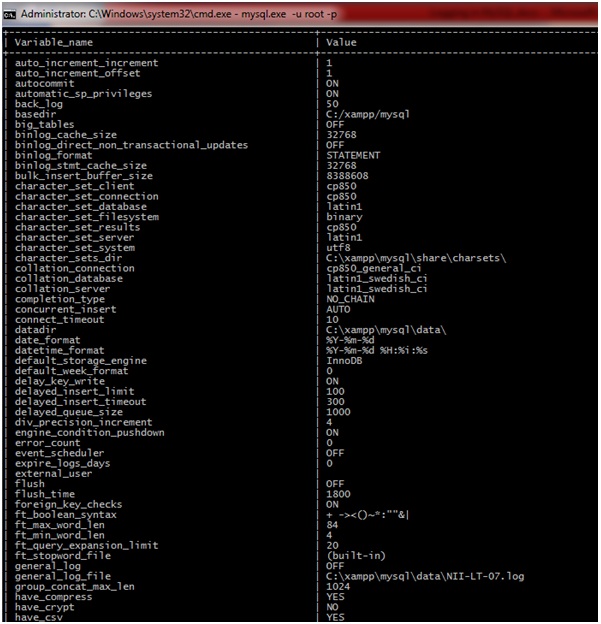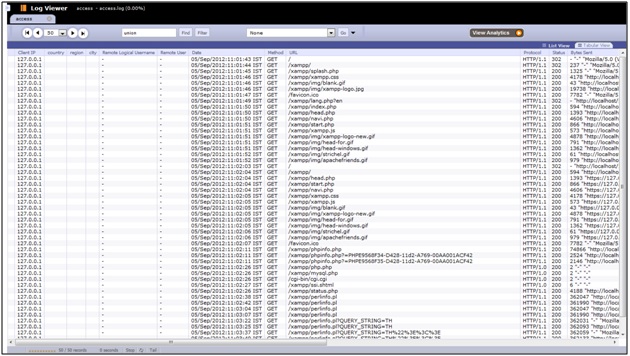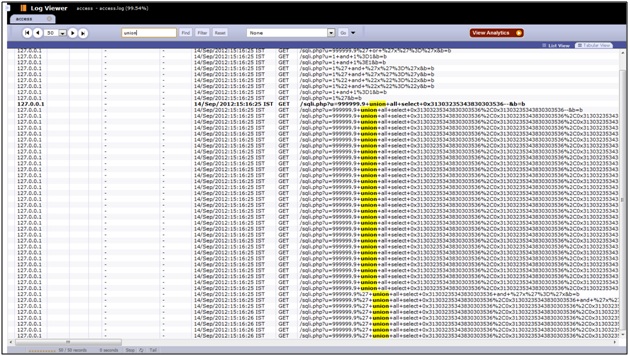Scope:
This article demonstrates logging techniques in MySQL to uncover and analyze any mischief attempts done by (outside or inside) user focusing on specific areas in database.
Getting Started:
Following are the types of logs available in MySQL[1].
|
Log Type |
Information Written to Log |
| Error log | Problems encountered starting, running, or stopping mysqld |
| General query log | Established client connections and statements received from clients |
| Binary log | Statements that change data (also used for replication) |
| Relay log | Data changes received from a replication master server |
| Slow query log | Queries that took more than long_query_time seconds to execute |
By Default, logging is not enabled in MySQL. To enable that use command “show processlist”.
mysql>show processlist;
Note: This shows all running queries. Info column in result shows the query which is executed.

Now this is only showing data for current session. If you want to see all the queries being executed on the server then you should log them first.
We have seen different types of logging in MySQL, so which one to use? We will use General Log, which will give us all the queries executed at the server.
How to go about it?
- Check logging is enabled or not
- What type of logging is enabled (FILE, TABLE, BOTH)?
- If not enabled, how to enable it?
- What to check?
Checking if logging is enabled or not
Simply log into the MySQL prompt and issue following command
mysql> show variables;
This will list all the global variables in MySQL. Look for general_log variable and its value; Ideally if logging is not enabled then its value would be “OFF” and general_log_file variable would be:
For *NIX: “/var/lib/mysql/mysql.log”
For Windows (XAMPP setup): “C:\xampp\mysql\data\<system_name>.log”
What type of logging is enabled (FILE, TABLE, BOTH)?
- You can determine whether logging is of what type by looking output of following variable.
log_output = ‘FILE|TABLE|BOTH’
- You can change the value of this using following command
mysql> SET GLOBAL log_output = ‘FILE’;

If logging not enabled, how to enable it?
As logging is not enabled, let’s enable that first. To do that, issue the following command.
mysql>SET GLOBAL general_log = ‘ON’;
mysql>SET GLOBAL general_log_file = ‘path_on_your_system’;
Similarly you can set the logging for slow query log.
mysql>SET GLOBAL slow_query_log = ‘ON’;
mysql>SET GLOBAL slow_query_log_file = ‘path_on_your_system’;
Slow query logs are basically those which took longer time to execute then specified value in “long_query_time”
What to check?
So, we have all the required logs. What Next?
Let’s Analyze.
What could be wrong?
- It could be attack from web, most common being SQL Injection
- What about somebody from inside? Privilege escalation or data stealing?
In both the cases, who did it? Let’s find out….
Case 1:
Suppose, somebody got a weak link in the application, and got into the system by some SQL Injection. I don’t have to explain what is SQL Injection is, well I may can tell you what someone can do with SQL Injection. For the attacker, there can be only one entry point, but in backend there are many things, like web server, database server, etc.
Let’s look at web server log (in our case its apache logs). During normal operations, things would look pretty simple and straight forward. At the glance it looks neat and clean.

Let’s search for something, like “select”, if anyone is trying to run a SQL query

Similarly we can search for “union” or any other such SQL command to see if there is any suspicious activity is going on.

It is Interesting to see that we have some requests which have SQL queries in the request parameters. This indicates that there is something suspicious about these requests as timestamp is same for few queries. It simply means attacker has run an automated scanner to exploit the vulnerability.
Suspicious log snippet:
127.0.0.1 - - [14/Sep/2012:15:45:10 +0530] "GET /sqli.php?u=999999.9%27+union+all+select+%28select+concat%280x7e%2C0x27%2C0x7233646D3076335F68766A5F696E6A656374696F6E%2C0x27%2C0x7e%29+limit+0%2C1%29%2C0x31303235343830303536+and+%27x%27%3D%27x HTTP/1.1" 200 54 "-" "Mozilla/4.0 (compatible; MSIE 7.0; Windows NT 5.1; SV1; .NET CLR 2.0.50727)”
127.0.0.1 - - [14/Sep/2012:15:45:10 +0530] "GET /sqli.php?u=999999.9%27+union+all+select+concat%280x7e%2C0x27%2Cunhex%28Hex%28cast%28database%28%29+as+char%29%29%29%2C0x27%2C0x7e%29%2C0x31303235343830303536+and+%27x%27%3D%27x HTTP/1.1" 200 42 "-" "Mozilla/4.0 (compatible; MSIE 7.0; Windows NT 5.1; SV1; .NET CLR 2.0.50727)”
127.0.0.1 - - [14/Sep/2012:15:46:05 +0530] "GET /sqli.php?u=999999.9%27+union+all+select+concat%280x7e%2C0x27%2Cunhex%28Hex%28cast%28user%28%29+as+char%29%29%29%2C0x27%2C0x7e%29%2C0x31303235343830303536+and+%27x%27%3D%27x HTTP/1.1" 200 47 "-" "Mozilla/4.0 (compatible; MSIE 7.0; Windows NT 5.1; SV1; .NET CLR 2.0.50727)”
127.0.0.1 - - [14/Sep/2012:15:46:05 +0530] "GET /sqli.php?u=999999.9%27+union+all+select+concat%280x7e%2C0x27%2Cunhex%28Hex%28cast%28version%28%29+as+char%29%29%29%2C0x27%2C0x7e%29%2C0x31303235343830303536+and+%27x%27%3D%27x HTTP/1.1" 200 39 "-" "Mozilla/4.0 (compatible; MSIE 7.0; Windows NT 5.1; SV1; .NET CLR 2.0.50727)”
127.0.0.1 - - [14/Sep/2012:15:46:05 +0530] "GET /sqli.php?u=999999.9%27+union+all+select+concat%280x7e%2C0x27%2Cunhex%28Hex%28cast%28database%28%29+as+char%29%29%29%2C0x27%2C0x7e%29%2C0x31303235343830303536+and+%27x%27%3D%27x HTTP/1.1" 200 42 "-" "Mozilla/4.0 (compatible; MSIE 7.0; Windows NT 5.1; SV1; .NET CLR 2.0.50727)”
127.0.0.1 - - [14/Sep/2012:15:46:05 +0530] "GET /sqli.php?u=999999.9%27+union+all+select+concat%280x7e%2C0x27%2Cunhex%28Hex%28cast%28system_user%28%29+as+char%29%29%29%2C0x27%2C0x7e%29%2C0x31303235343830303536+and+%27x%27%3D%27x HTTP/1.1" 200 47 "-" "Mozilla/4.0 (compatible; MSIE 7.0; Windows NT 5.1; SV1; .NET CLR 2.0.50727)”
127.0.0.1 - - [14/Sep/2012:15:46:05 +0530] "GET /sqli.php?u=999999.9%27+union+all+select+concat%280x7e%2C0x27%2Cunhex%28Hex%28cast%28%40%40hostname+as+char%29%29%29%2C0x27%2C0x7e%29%2C0x31303235343830303536+and+%27x%27%3D%27x HTTP/1.1" 200 42 "-" "Mozilla/4.0 (compatible; MSIE 7.0; Windows NT 5.1; SV1; .NET CLR 2.0.50727)”
127.0.0.1 - - [14/Sep/2012:15:46:05 +0530] "GET /sqli.php?u=999999.9%27+union+all+select+concat%280x7e%2C0x27%2Cunhex%28Hex%28cast%28%40%40basedir+as+char%29%29%29%2C0x27%2C0x7e%29%2C0x31303235343830303536+and+%27x%27%3D%27x HTTP/1.1" 200 47 "-" "Mozilla/4.0 (compatible; MSIE 7.0; Windows NT 5.1; SV1; .NET CLR 2.0.50727)”
Once you are sure that there is an incident of SQL Injection by an unknown IP then you can proceed with the formal procedure of investigating this issue with cyber cell.
Case 2:
Now let’s consider the second case, where MySQL user who has access to database has done some mischiefs. Popular activities possible are:
- Running privileges escalation attacks
- Getting root password (will see how)
- Dumping database(s) into files
Note: There are few privilege escalation attacks available in Metasploit also.
For getting the root password is fairly simple. A low privilege user just has to execute following command on the prompt.
mysql> SELECT LOAD_FILE(‘C:\xampp\mysql\data\mysql\user.MYD’);
Note: The path will change as per the setup.
If you are not getting any result then you should have physical access to this file, ssh, RDP, etc. Basically we just need data of this file.
This is a binary file containing the MySQL user information with username and password. So if you are root user then you can simply run following query to see all users.
mysql> select Host, User, Password from mysql.user;

When low privilege user (fdb in our case) tries to run this query, obviously he will get access denied error. At this instance our previous query will be handy, reading binary file. So, what is the problem now? Simple, the password is stored in MD5 hashJ. Cracking this would not take much time.
Note: Tools like md5crack, John the Ripper, Cain & Adel do a fine job of cracking MD5 hashes.
Considering the last part, where user is dumping the database into file for some notorious purpose, we can check the same in our general_log or slow_query_log for such queries. In this case we are opening this log file in and we will do some manual analysis first.
Here is snippet of the query log:
325 Connect root@localhost on
325 Init DB forensics
325 Query SELECT * FROM forensics_test where uname = '999999.9' union all select (select distinct concat(0x7e,0x27,unhex(Hex(cast(schema_name as char))),0x27,0x7e) from `information_schema`.schemata limit 3,1),0x31303235343830303536 and 'x'='x'
325 Quit
326 Connect root@localhost on
326 Init DB forensics
326 Query SELECT * FROM forensics_test where uname = '999999.9' union all select (select distinct concat(0x7e,0x27,unhex(Hex(cast(schema_name as char))),0x27,0x7e) from `information_schema`.schemata limit 4,1),0x31303235343830303536 and 'x'='x'
326 Quit
327 Connect root@localhost on
327 Init DB forensics
327 Query SELECT * FROM forensics_test where uname = '999999.9' union all select (select distinct concat(0x7e,0x27,unhex(Hex(cast(schema_name as char))),0x27,0x7e) from `information_schema`.schemata limit 5,1),0x31303235343830303536 and 'x'='x'
327 Quit
328 Connect root@localhost on
328 Init DB forensics
328 Query SELECT * FROM forensics_test where uname = '999999.9' union all select (select distinct concat(0x7e,0x27,unhex(Hex(cast(schema_name as char))),0x27,0x7e) from `information_schema`.schemata limit 6,1),0x31303235343830303536 and 'x'='x'
328 Quit
329 Connect root@localhost on
329 Init DB forensics
329 Query SELECT * FROM forensics_test where uname = '999999.9' union all select (select distinct concat(0x7e,0x27,unhex(Hex(cast(schema_name as char))),0x27,0x7e) from `information_schema`.schemata limit 7,1),0x31303235343830303536 and 'x'='x'
329 Quit
330 Connect root@localhost on
330 Init DB forensics
330 Query SELECT * FROM forensics_test where uname = '999999.9' union all select (select distinct concat(0x7e,0x27,unhex(Hex(cast(schema_name as char))),0x27,0x7e) from `information_schema`.schemata limit 8,1),0x31303235343830303536 and 'x'='x'
330 Quit
What we basically search is statements like “union select”, query to “information_schema” database, query to “mysql” database, etc. Then analyze it further to conclude on a result.
Conclusion
Only logging will not do the job, it is also important to do analysis after that. Frequently, database administrator(s) only enable logging features, and leave just like that. But the actual analysis behind it is much more important. One thing that I shouldn’t be mentioning is that, using this technique you can extract all the queries used by an automated scanner like, Havij, SQLMap, etc. I personally do not recommend that, but once you know the queries these tools run you will better understand SQL Injection.
References:
- http://dev.mysql.com/doc/refman/5.1/en/server-logs.html
Dhiraj Ranka is currently working as Senior Security Analyst at Network Intelligence, Mumbai for more than four years. He is additionally involved in intensive research and Web-based applications testing, intended primarily for executing vulnerability assessment projects and delivering trainings.
Really very helpful one..as it is for MySQL, but it give us idea what we have to look for in logs to identify and suspicious activity